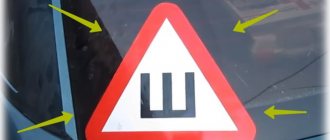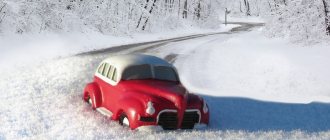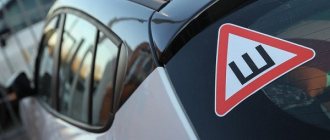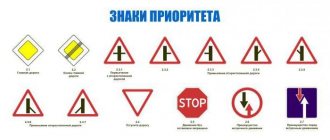Among the list of traffic rules identification signs, the “Spikes” sign was perceived ambiguously by drivers for a long time: the requirement to install it when using studded tires was not always considered mandatory. At the same time, studs have a significant impact on safety, and changes in traffic legislation could not fail to take this into account.
Until recently, the presence of the “Spikes” sign on cars with studded tires was mandatory, and its absence was subject to a fine of 500 rubles or a warning.
From December 8, 2021, the “Spikes” sign is excluded from the traffic rules (note – Government Decree No. 1414 of November 24, 2018). That is, now the presence of the “Spikes” sign on vehicles is not mandatory, and accordingly, a fine for its absence is no longer imposed.
However, there are quite good reasons why we recommend that drivers continue to mark their vehicles with the “Spikes” sign in the winter when driving on studded wheels. Below you will find answers to the following questions:
- Why was the mandatory use of the “Spikes” sign canceled?
- Why should you continue to use the “Spikes” sign?
- What size should the “Spikes” sign be and where is the best place to glue it?
- Additional information about the cancellation of the fine for the absence of the “Spikes” sign.
Why o?
When the “Spikes” sign was declared mandatory to designate cars with studded tires, the logic of the legislators was that a car with such tires brakes much more sharply. Therefore, the driver following you must be aware of your spikes in order to maintain a sufficiently large distance.
In fact, contrary to this logic, the braking distance of a car depends primarily on its weight, the presence of electronic safety systems and weather conditions. The mere presence or absence of studs on a tire, if it has any effect, is far from primary.
Perhaps 30 years ago the “Spikes” sign had some meaning, when everyone drove all-season tires and studs were quite rare. Then, probably, cars with spikes really braked noticeably sharper than all other cars. But nowadays this is no longer the case.
The “Spikes” sign has lost its original meaning, since today more than 70% of motorists, that is, the vast majority, drive studded tires. Therefore, if you need to mark some cars in traffic with winter tires, then it would be more logical to stick the sign on cars with Velcro rather than with studs.
Technical inspection
The process of carrying out a technical inspection of a car involves checking its compliance with a strict list of requirements, which are the basis for allowing the car to participate in driving on public roads.
Therefore, such a fact as the absence of a “Spikes” sticker on vehicles with studded tires may be a reason for refusal to carry out a technical inspection. To avoid problems and difficulties with completing the annual procedure, you should worry about purchasing a “Spikes” sticker in advance.
Although you can resort to the option of replacing the wheels while the vehicle undergoes a technical inspection. However, the second option cannot be called rational, since the cost of re-shoeing the car is several times higher than the cost of the sticker.
Why then stick the “Spikes” sign on your car?
The use of studded tires in winter created not only safer and more comfortable conditions for drivers and passengers of such “re-shod” cars, but also certain problems for other road users, especially those driving behind.
The main danger from cars with “spikes” is small crushed stone, which can fly out from under the studded wheels and damage the car driving behind, or even injure the driver. And a spike flying out of a tire can also seriously damage the windshield.
It is for the reasons mentioned above that we recommend that all conscious drivers continue to mark their cars with the “Spikes” sign when using studded tires.
By the way, experienced motorists can recall cases when traffic police inspectors concluded that cars colliding “in single file” on a slippery road were mutually at fault only because the car ahead on spikes did not have the “Spikes” identification mark installed. And no appeals to the fact that the rear car did not keep the required distance helped.
Another thing is that the use of new technologies in the production of car tires has made it possible to create models of winter tires that are not only not inferior in braking efficiency to studded ones, but also superior to them in many situations (studs or Velcro - which is better?). Therefore, an increased distance to the car in front must be maintained by cars with spikes too.
What does the Thorns sign show?
Before studying the legal part of the problem, you should familiarize yourself with the sign itself.
And first, it’s worth finding out what the “W” means on the vehicle window. Most car owners will immediately answer that “spikes” need to be stuck on so that other road users receive information about using studded wheels on their car in winter. However, this letter also has another function, directly related to the one already indicated.
Due to the properties of the studded tread, which makes it possible to stop a car much faster than a car without studs, this sign warns cars following behind to maintain an increased distance, so that in the event of emergency braking they do not get hit in the rear bumper.
It is important to determine the unsuitability of tires in time.
A tire is considered worn out when the remaining tread is at the minimum permissible value, or the rubber has any visible damage:
- small or large cuts;
- cracks in the cord;
- frame delamination;
- the sidewalls or the tread itself are swollen;
- breakdowns;
- The sides came off.
The production of studded wheels is established at many enterprises, and its quality varies depending on the manufacturer.
Therefore, the spikes tend to simply fly out from under the car. Accordingly, car owners following behind vehicles must be warned. Otherwise, you can end up with a metal product in the windshield, and with it the expensive installation of a new windshield.
What size should the “Spikes” sign be and where should it be placed?
Before the abolition of the mandatory use of the “Spikes” sign, with the beginning of the winter season in car dealerships, the stock of stickers with its image was often insufficient.
In this regard, the independent production of a sign was very relevant and many car enthusiasts needed information about the shape, size and color scheme of the sign.
- In accordance with the old version of the Road Traffic Rules, the “Spikes” sign is an equilateral triangle with the letter “W” inside it.
- The triangle is positioned with the apex up, and the length of the side is at least 20 cm.
- Along the sides of the triangle there is a border, the width of which is ten percent of the length of the side.
- Color scheme: the sign has a white background, a red border, and the letter “Ш” is black.
Where can I download the “Spikes” sign and how to print it correctly?
If you have the opportunity to use a color printer, then the “Spikes” sign can then be printed. It is advisable to do this on thick paper, for example, photo paper with a density of up to 150 g/m2, otherwise the sign will turn out to be short-lived.
If only a black and white printer is available, then we suggest, and the printout will need to be modified: use a brush with red paint or a red felt-tip pen to color the edge of the sign.
Where should the “Spikes” sign be placed?
The “Spikes” sign must be placed “behind” motor vehicles. Most often, it is glued in the upper corner of the rear window of the car on the inside - this place is convenient both for informing the driver driving behind and for ensuring the durability of the sign itself.
However, other installation locations do not contradict the traffic regulations, for example, on the bumper or on the rear trunk lid. Only in this case will the sign be exposed to precipitation and may quickly become unusable.
As for the use of a homemade “Spikes” sign of non-standard sizes, it should not be made smaller than the recommended minimum, but a significantly larger sign is also undesirable - when installed on the rear window, this may unacceptably restrict the driver’s visibility.
Where should I glue it?
In paragraph 8 of the Basic Provisions it is noted that the “Spikes” notification sticker may be located on the rear panel of the body or window of the car. The owner of the car determines the location of the marking element at his own discretion.
According to experienced driving school instructors, the light element with the image of the letter “W” is clearly visible from the upper corner of the rear window. If there is tinting, a sign warning about studded tires is glued to the outside. Transparent glass allows the placement of a marking element from inside the cabin.
This is interesting: Chevrolet Cruze sedan design review: photos and analysis
When replacing winter tires with summer tires, it is not necessary to remove the corresponding sticker. This situation is not considered an offense. However, every road user is obliged not only to comply with traffic rules, but also to treat other motorists with respect. In summer, it is recommended to remove the “Spikes” sign from the car.
On the abolition of the fine for the absence of the “Spikes” sign
Previously, the absence of the “Spikes” sign referred to malfunctions in which the operation of the car was prohibited. Therefore, the punishment for failure to comply with the requirement to install it was regulated by the relevant article of the Code of Administrative Offences:
| Article of the Administrative Code | The content of the article | Responsibility for violation |
| 12.5 part 1 | Driving a vehicle in the presence of malfunctions or conditions under which, in accordance with the Basic Provisions for the admission of vehicles to operation and the duties of officials to ensure road safety, operation of the vehicle is prohibited, with the exception of malfunctions and conditions specified in parts 2 - 7 of this article | Punishment: warning or administrative fine in the amount of five hundred rubles Cases are considered by: Internal Affairs bodies |
But since the current version of the traffic rules does not provide for the use of the “Spikes” sign, there is also no punishment for its absence.
By the way, in accordance with the Road Traffic Regulations, motorists are required to use winter tires from December to March. At the same time, by local legislation it can be either reduced or increased, because winter in Norilsk and Rostov proceeds differently.
Car enthusiasts often wonder whether the opposite situation is a violation: a “Spikes” sign installed on a car in the summer (more precisely, installed in the winter and not removed in the summer). The Rules do not say anything about installing a sign during a strictly defined period, and, therefore, this situation is not a violation, and there is no need to fear a fine. And the margin of distance that the driver driving behind will set in the presence of a sign will not hurt at all.
Why notify about studded tires?
Most regions of the Russian Federation are dominated by a harsh climate with frequent precipitation in the form of snow and heavy rains. Due to poor climatic conditions in the autumn-winter period, drivers are forced to install studded tires on their cars.
Car tires with metal studs improve vehicle cross-country ability in difficult weather conditions and prevent slipping on snow and ice-covered roads.
Not every motorist knows that studded tires pose a danger to all road users. Understanding and mutual respect on the road reduces the number of traffic accidents. The “Spikes” sign pasted on the body or rear window of the passenger compartment means that the car in front is equipped with tires with metal spikes.
The main reasons for installing a warning sticker include:
- Notifying traffic participants about the presence of studded tires on the vehicle ahead.
- Maintaining distance while driving. A car with studded tires has a shorter braking distance during emergency braking.
- Warning against possible damage. When driving at high speed, the number of wheel revolutions increases. Flying metal inserts can damage neighboring machines.
- Guilt in case of a traffic accident. The driver of a car moving in front with studded tires may be found guilty of an accident if the “Spikes” marking element was not installed on the car.
- Passing a technical inspection. The absence of the “Spikes” sign on a car with studded tires may result in refusal to issue a vehicle inspection ticket. Further use of the vehicle is prohibited.
This is interesting: How to choose the best navigator for a truck? 3 main and 8 additional functions of navigators
The above-mentioned options for the development of various situations on the road can be costly for the car owner.
“Blue Buckets”: “The “Spikes” sign does not affect the accident rate
Most car enthusiasts agree that the “Spikes” sign is another useless invention of officials. On this issue, the coordinators of the most famous community fighting rudeness and arbitrariness on the roads, “Blue Buckets,” agree with them.
Representatives of this organization unanimously express an unambiguous opinion regarding the adoption of the Law on the mandatory fixation of the “Spikes” triangle on a vehicle.
According to movement activists, the warning sign is in no way capable of influencing accident rates on domestic roads. They also believe that stories about different braking distances between studded tires and Velcro can be questioned, although all tests are provided by reputable agencies.
Representatives of the Blue Buckets believe that the introduction of a mandatory sticker was done so that the state treasury could be replenished as much as possible at the expense of motorists. After all, even the hype for the wholesale sale of stickers cannot bring in much revenue. But massive fines to vehicle owners will bring much more money.
Opinion of car owners: “The “Spikes” sticker is another reason to once again take possession of the people’s funds!”
Representatives of the above organization are also supported by the majority of car enthusiasts in the country. After all, after traffic inspectors began to massively use the opportunity to fine drivers for not having a sticker on the rear window or trunk lid, the flurry of negative emotions is only increasing every day.
Many vehicle owners consider the need to attach a “Spikes” warning sticker to the rear of the car an absurd decision. The most common opinion among drivers is that in this way the state is trying to put its hand in the pockets of ordinary people, and drivers associate the cover of accident statistics with an attempt to divert attention from the real goals of the company.
At the same time, motorists say that none of them would resist the introduction of stickers if they brought real benefits. After all, it’s not a problem to buy a sticker for little money or order it from the nearest printing house, and then hang it on the glass.
People are outraged by the complete nonsense and absurdity of this situation, since even a dozen warning triangles cannot reduce the level of danger on the road in winter until people themselves begin to comply with traffic rules.
It should be remembered that the accident situation, for the most part, depends on the condition of the road surface. And if the state treasury is trying to replenish itself thanks to the funds of car owners, then they all want the incoming funds to be spent on high-quality and timely repair work.
But the main thing is the issue of fines. Therefore, in order to avoid losing your own finances to pay fines, it is better to order or purchase a sticker.
No matter how experienced the driver the vehicle owner is, some important rules for operating a car on studded wheels should be known and constantly applied in practice.










